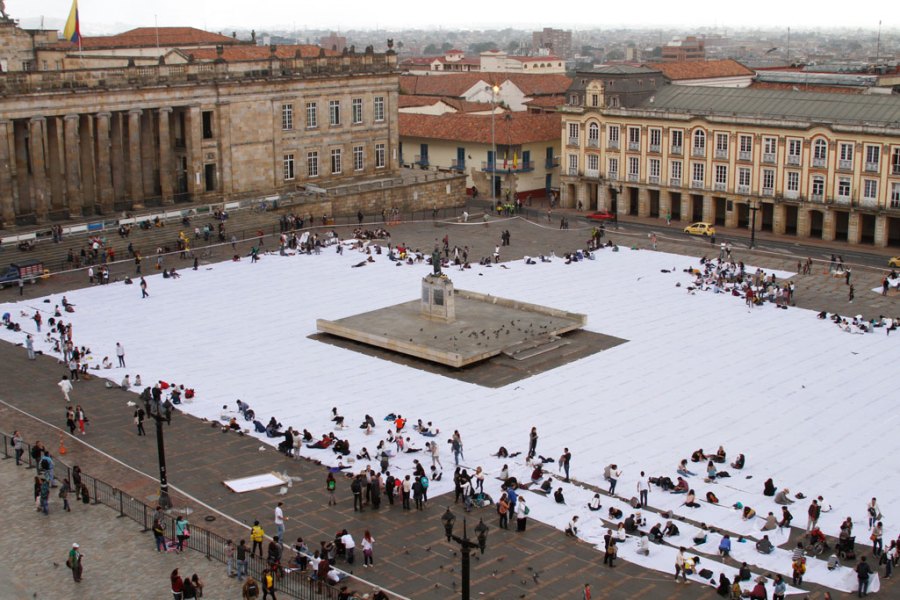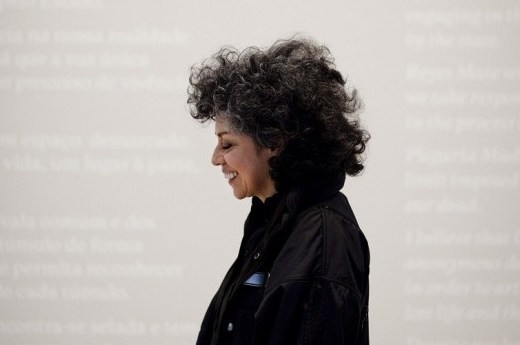Over a 500-year history, it has hosted markets, circuses, even (under Spanish colonial rule) executions. And on the day I visit, Plaza de Bolívar, the central square of Bogotá, is typically lively. The Colombian nation has recently voted in a referendum to reject a peace treaty with the Farc guerrilla group, which would have ended a decades-long civil war. The vote was close – 50.2 per cent defeating 49.8 – and hundreds of protesters against the result have set up camp in the Plaza. They’re here for the long haul, until peace is finally signed, they say – and they’ve the camping stoves and tents to prove it.
Plaza de Bolívar is the beating heart of Colombia. Imagine if the Supreme Court, Houses of Parliament, Westminster Abbey, and City Hall were found on the four sides of Trafalgar Square and you’d get some idea; the Plaza’s north, south, east and west are home to the Palace of Justice, Colombian Congress, city cathedral, and mayor’s office respectively. When people want to voice grievances, they come here. Which is to say the ‘camp for peace’ is hardly unique. In recent years, protests have been staged by farmers, teachers, indigenous groups and countless others. Here they thrust themselves to the centre of national attention, with photographers and film crews never far off.
It is sometimes said that the Plaza has become a canvas and protesters the artists. For all its troubles – and reputation worldwide as a hub for producing and distributing drugs – Colombia boasts the longest-running continuous democracy in Latin America, and the freedom of expression one sees in Plaza de Bolívar is a manifestation of that. In 2011, campaigners against the use of landmines placed 9,100 mutilated boots about the square to commemorate the number of Colombians killed by such explosives in the previous two decades.
Artists themselves haven’t been slow to see the Plaza’s potential either, keen to express themselves at the political, legal, and religious core of the country. America’s Spencer Tunick held one of his naked mass gatherings here last June, which saw some 6,000 people disrobe in the name of diversity. Colombia’s population is a rich mix of European, Amerindian, and African heritage, and Tunick said his aim was to capture ‘an alphabet soup of skin tonalities’.
It’s one of Bogotá’s own, however, who has engaged with the Plaza most potently – and frequently. Doris Salcedo, probably Colombia’s most famous artist after (Medellín-born) Fernando Botero, has for years treated it like her own personal studio. On 6 and 7 November 2002, for instance, she lowered 280 empty chairs from the roof of the Palace of Justice, honouring the victims of a two-day siege at the Palace exactly 17 years earlier by the M-19 rebel group (who had been in cahoots, it is alleged, with cocaine kingpin, Pablo Escobar).
In October 2016, Salcedo returned to the square immediately after the referendum result. With the help of scores of volunteers, she began sewing together more than 2,000 rectangles of white cloth, each with a different victim of the civil war’s name inscribed on it in ash. The resulting tapestry, Sumando Ausencias (Adding Up Absences), was large enough to cover the whole square; the act of its creation one of togetherness at a time of great division. In photographs from above, it looked like an ice rink or snow scene; Salcedo called it a ‘collective act of mourning’. Mourning for the dead, who, like the hopes for peace, like snow or ice, like Sumando Ausencias itself (which Salcedo removed from the square within 24 hours), proved short-lived.
In contrast, at the centre of the Plaza is a neoclassical statue that’s anything but short-lived. It was made, in 1846, to last as long as Colombia itself. It’s of Simón Bolívar, the hero of Latin American independence after whom the Plaza is now named. (The square is as old as the city, dating back to the foundation of Bogotá in the mid 16th century by Spanish conquistadors. The original name was Plaza Mayor.)
It’s not always upheaval or commotion here, of course. There are some days of tranquility and calm, when Señor Bolívar is alone apart from a few tourists feeding pigeons. But not too many days. As I write this, now back in the UK, the camp has gone, and Colombia’s president Juan Manuel Santos – fresh from winning the Nobel Peace Prize – has brokered a new peace deal. It has been ratified by Congress, though other rebel groups remain to be negotiated with and there’s criticism that this time around he is skipping a public vote.
What can we expect at Plaza de Bolívar in 2017? A concert for peace? Another artist intervention? Quite probably. Further protests? Almost certainly. It’s literally a case of ‘watch this space’.
From the March 2017 issue of Apollo. Preview and subscribe here.
Unlimited access from just $16 every 3 months
Subscribe to get unlimited and exclusive access to the top art stories, interviews and exhibition reviews.














![Masterpiece [Re]discovery 2022. Photo: Ben Fisher Photography, courtesy of Masterpiece London](http://www.apollo-magazine.com/wp-content/uploads/2022/07/MPL2022_4263.jpg)
It’s time for the government of London to return to its rightful home